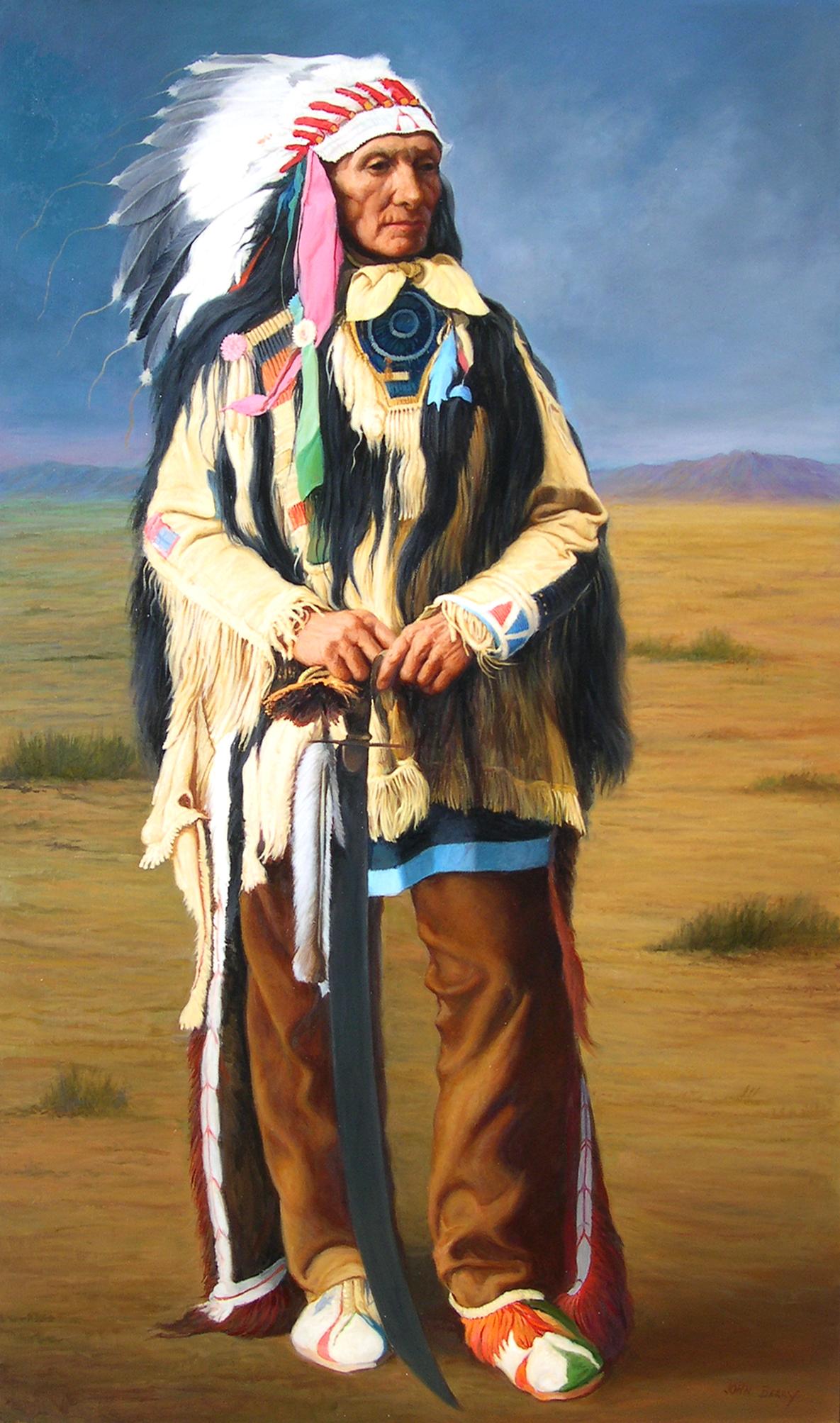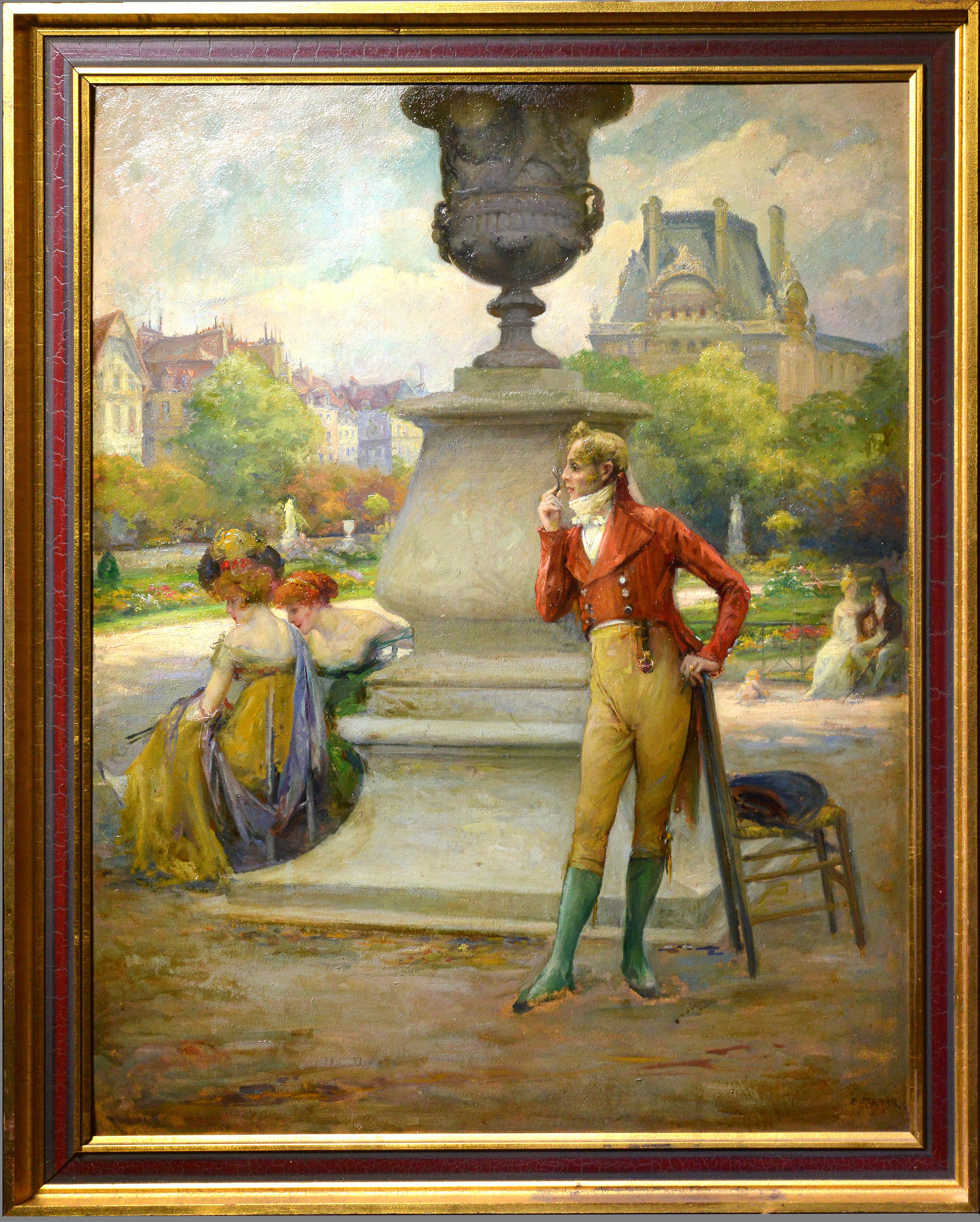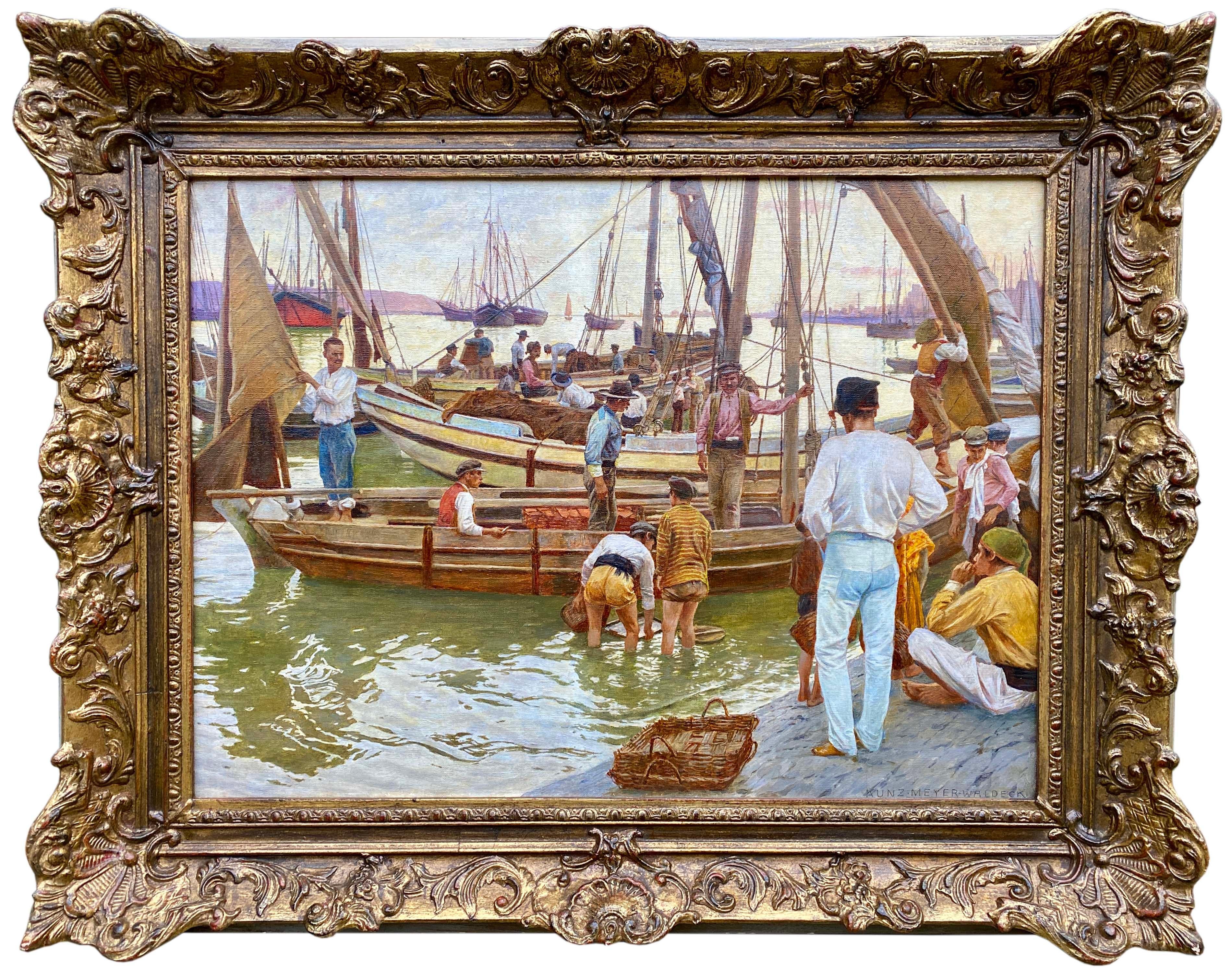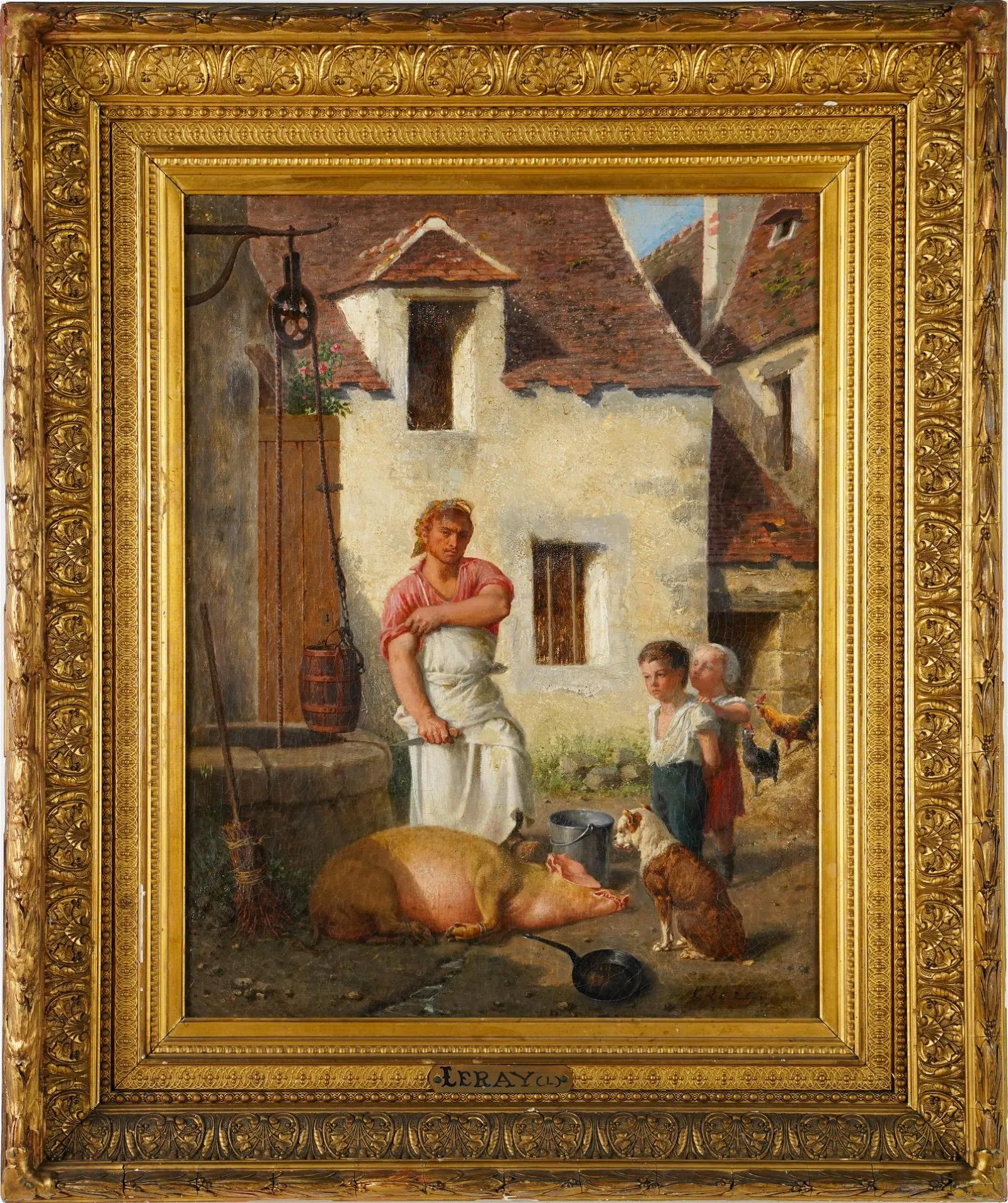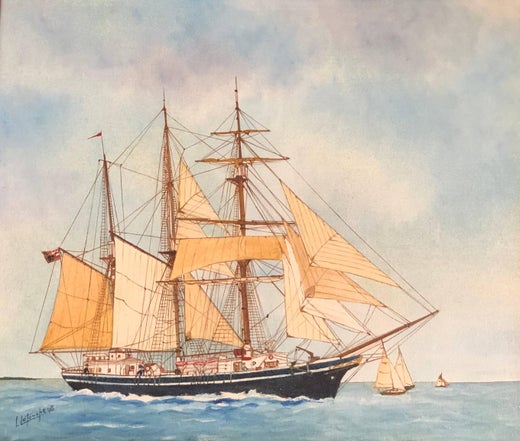Items Similar to The Santa Maria - Christopher Columbus's ship, signed oil painting
Want more images or videos?
Request additional images or videos from the seller
1 of 9
Louis LetoucheThe Santa Maria - Christopher Columbus's ship, signed oil paintingC. 1996
C. 1996
About the Item
The Santa Maria, 1490
by Louis Letouche (French 1924-2015)
oil painting on linen canvas, stretched over board
framed
Framed size: 16 x 19 inches
Superb oil painting by the well listed French marine artist Louis Letouche (1924-2015). The painting portrays one of the most important ships in maritime history: The Santa Maria.
La Santa María de la Inmaculada Concepción (Spanish for: The Holy Mary of the Immaculate Conception), or La Santa María, originally La Gallega, was the largest of the three ships used by Christopher Columbus in his first voyage. Her master and owner was Juan de la Cosa.
Santa María was built in Pontevedra, Galicia, in Spain's north-west region. Santa María was probably a medium-sized nau (carrack), about 58 ft (17.7 m) long on deck, and according to Juan Escalante de Mendoza in 1575, Santa Maria was "very little larger than 100 toneladas" (about 100 tons, or tuns) burthen, or burden, and was used as the flagship for the expedition. Santa María had a single deck and three small masts.
The other ships of the Columbus expedition were the smaller caravel-type ships Santa Clara; one particular ship sailed for 46 years and was remembered as La Niña ("The Girl"), and La Pinta ("The Painted"). All these ships were second-hand (if not third- or more) and were not intended for exploration. Niña, Pinta, and the Santa María were modest-sized merchant vessels comparable in size to a modern cruising yacht. The exact measurements of length and width of the three ships have not survived, but good estimates of their burden capacity can be judged from contemporary anecdotes written down by one or more of Columbus's crew members, and contemporary Spanish and Portuguese shipwrecks from the late 15th and early 16th centuries which are comparable in size to that of Santa María. These include the ballast piles and keel lengths of the Molasses Reef Wreck and Highborn Cay Wreck in the Bahamas. Both were caravel vessels 19 m (62 ft) in length overall, 12.6 m (41 ft) keel length and 5 to 5.7 m (16 to 19 ft) in width, and rated between 100 and 150 tons burden.[7] Santa María, being Columbus' largest ship, was only about this size, and Niña and Pinta were smaller, at only 50 to 75 tons burden and perhaps 15 to 18 metres (49 to 59 ft) on deck.
With three masts, Santa María was the slowest of Columbus' vessels but performed well in the Atlantic Ocean crossing. Then on the return trip, on 24 December (1492), not having slept for two days, Columbus decided at 11:00 p.m. to lie down to sleep. The night being calm, the steersman also decided to sleep, leaving only a cabin boy to steer the ship, a practice which the admiral had always strictly forbidden. With the boy at the helm, the currents carried the ship onto a sandbank, running her aground off the present-day site of Cap-Haïtien, Haiti. It sank the next day. Realizing that the ship was beyond repair, Columbus ordered his men to strip the timbers from the ship. The timbers were later used to build a fort which Columbus called La Navidad (Christmas) because the wreck occurred on Christmas Day, north from the modern town of Limonade.
Santa María carried several anchors, possibly six. One of the anchors now rests in the Musée du Panthéon National Haïtien (MUPANAH), in Port-au-Prince, Haiti. On 13 May 2014, underwater archaeological explorer Barry Clifford claimed that his team had found the wreck of Santa María. In the following October, UNESCO's expert team published their final report, concluding that the wreck could not be Columbus's vessel. Fastenings used in the hull and possible copper sheathing dated it to the 17th or 18th century.
Columbus' crew was not composed of criminals as is widely believed. Many were experienced seamen from the port of Palos in Andalusia and its surrounding countryside, as well as from the region of Galicia in northwest Spain. It is true, however, that the Spanish sovereigns offered an amnesty to convicts who signed up for the voyage; still, only four men took up the offer: one who had killed a man in a fight, and three friends of his who had then helped him escape from jail.
The painting is by the very talented French marine artist, Louis Letouche (1924-2015). The artist began painting passionately in 1958. Self taught, he turned to marine portraiture in which he excelled. Never seeking fame or the highlight, the artists work has been relatively unknown until now a couple of years after his death. We are very pleased to introduce you to his work, having acquired a number of marine portraits by this artist, all of which came from the artists estate.
For the collector of maritime paintings and history, they offer a fascinating and unique insight into our maritime past - and for any marine themed interior, they make wonderful interior decoration. They offer potential as a single painting on the "den" wall, pairs hung either side of a fireplace or even whole sets grouped together to really make a powerful statement within a themed space.
Condition report:
The painting is in very good condition. If you will excuse the pun, we can "ship" this painting worldwide!
- Creator:Louis Letouche (1924 - 2015, French)
- Creation Year:C. 1996
- Dimensions:Height: 16 in (40.64 cm)Width: 19 in (48.26 cm)Depth: 1 in (2.54 cm)
- Medium:
- Movement & Style:
- Period:
- Condition:
- Gallery Location:Cirencester, GB
- Reference Number:1stDibs: LU50932591621
Louis Letouche
Louis Letouche was passionate about painting. He began to paint in 1958. Self-taught he turned to figurative painting privileging the landscapes and portraits of marine.
Several exhibitions have been devoted to this painter around Paris Galleries.

About the Seller
5.0
Platinum Seller
These expertly vetted sellers are 1stDibs' most experienced sellers and are rated highest by our customers.
Established in 1989
1stDibs seller since 2016
3,540 sales on 1stDibs
Typical response time: 2 hours
- ShippingRetrieving quote...Ships From: Cirencester, United Kingdom
- Return PolicyA return for this item may be initiated within 3 days of delivery.
More From This SellerView All
- Sagres II Ship Portrait 20th Century, signed oil paintingBy Louis LetoucheLocated in Cirencester, GloucestershireSagres II, 1937 by Louis Letouche (French 1924-2015) oil painting on linen canvas, stretched over board framed Framed size: 18.25 x 13.75 inches Superb oil painting by the well listed French marine artist Louis Letouche (1924-2015). The painting portrays a Portugese Ship from the early 20th Century, titled: Sagres II. The three-masted ship was launched under the name Albert Leo Schlageter on 30 October 1937 at Blohm & Voss in Hamburg for Nazi Germany's Kriegsmarine. The ship was named after Albert Leo Schlageter, who was executed in 1923 by French forces occupying the Ruhr area. Her first commander was Bernhard Rogge. Sagres is a sister ship of the Gorch Fock, the Horst Wessel, and the Romanian training vessel Mircea. Another sister, Herbert Norkus, was not completed, while Gorch Fock II was built in 1958 by the Germans to replace the ships lost after the war. Following a number of international training voyages, the ship was used as a stationary office ship after the outbreak of World War II and was only put into ocean-going service again in 1944 in the Baltic Sea. On 14 November 1944 she hit a Soviet mine off Sassnitz and had to be towed to port in Swinemünde. Eventually transferred to Flensburg, she was taken over there by the Allies when the war ended and finally confiscated by the United States. In 1948, the U.S. sold her to Brazil for a symbolic price of $5,000 USD.She was towed to Rio de Janeiro where she sailed as a school ship for the Brazilian Navy under the name Guanabara. In 1961, Ambassador Teotónio Pereira of Portugal, who was also a man of the sea...Category
1990s Realist Portrait Paintings
MaterialsOil
- Danube, signed oil paintingBy Louis LetoucheLocated in Cirencester, GloucestershireDanube, 1855-1878 by Louis Letouche (French 1924-2015) oil painting on linen canvas, stretched over board framed Framed size: 14 x 19 inches Superb oil painting by the well listed...Category
1990s Realist Portrait Paintings
MaterialsOil
- Herzogin Cecilie, signed oil paintingBy Louis LetoucheLocated in Cirencester, GloucestershireHerzogin Cecilie, 1902 by Louis Letouche (French 1924-2015) oil painting on linen canvas, stretched over board framed Framed size: 15 x 21.75 inches Superb oil painting by the well listed French marine artist Louis Letouche (1924-2015). The painting portrays the early 20th Century ship titled: Herzogin Cecilie, 1902. Herzogin Cecilie was built in 1902 by Rickmers Schiffbau AG in Bremerhaven. She was yard number 122 and was launched on 22 April 1902. Completion was on 7 June that year. She was 334 feet 8 inches (102.01 m) long, with a breadth of 46 feet 3 inches (14.10 m) and a draught of 24 feet 2 inches (7.37 m). Herzogin Cecilie was built for Norddeutscher Lloyd Bremen. Unlike other contemporary German merchant sailing ships, the black Flying-P-Liners or the green ships of Rickmers, she was painted in white. She was one of the fastest windjammers ever built: she logged 21 knots at Skagen. The tall ships of the time remained competitive against the steamers only on the longer trade routes: the Chilean nitrate trade, carrying salpeter from Chile to Europe, and the Australian wheat trade, carrying grain from Australia to Europe. Both routes required rounding Cape Horn routinely, and were not well suited for steamers, as coal was in short supply there. Herzogin Cecilie was one of the fastest merchant sailing ships of her time, on a par with the Flying-P-Liners. The trip around Cape Horn from Portland (Oregon) to The Lizard (England) was done in 1903 in only 106 days. At the outbreak of World War I, she was interned by Chile, returning to Germany in 1920, only to be given to France as reparation, and subsequently sold to Gustaf Erikson (24 October 1872 – 15 August 1947) of Finland for £4250. She was homeported at Mariehamn.[2] As the freight rates for salpeter had dropped after the war, Gustaf Erikson sent her to bring grain from Australia. In so-called grain races, several tall ships tried to arrive first in Europe, to sell their cargo for a higher price, as told, for example, in The Great Tea Race of 1866 or The Last Grain Race. Typically, ships were loaded in the Spencer Gulf area, Port Victoria, South Australia or Wallaroo, South Australia, and travelled to Europe, with ports on the British Isles like Queenstown, Ireland or Falmouth, Cornwall being considered as the finish. After "winning" four times prior to 1921, she again won the grain race four times in eleven trips from 1926 to 1936. In 1927, when Herzogin Cecilie covered Port Lincoln (South Australia) –Falmouth, London and won a race against the Swedish ship Beatrice. Alan Villiers was on board, which would result in his book Falmouth for Orders, and later a trip aboard the barque Parma. Wreck of the Herzogin Cecilie in south Devon. With Sven Erikson as her Captain and Elis Karlsson her First Mate, the ship left Port Lincoln in South Australia on 21 January 1935, with a cargo of wheat, and after taking a more southerly route than usual, reached Falmouth for Orders on 18 May making her passage of 86 days the second fastest ever. Herzogin Cecilie was making for Ipswich in dense fog, when, on 25 April 1936, she grounded on Ham Stone Rock and drifted onto the cliffs of Bolt Head on the south Devon coast. After parts of the cargo were unloaded, she was floating again, only to be towed in June 1936 to Starhole (Starehole) Bay at the mouth of the nearby Kingsbridge Estuary near Salcombe, and beached there.On 18 January 1939, the ship capsized and sank. The remains of the ship sit at a depth of 7 metres at 50°12.82′N 3°47.02′W. The timber and brass portholes from the chart room...Category
1990s Realist Portrait Paintings
MaterialsOil
- Gota Lejon, signed oil paintingBy Louis LetoucheLocated in Cirencester, GloucestershireGöta Lejon, 1746. by Louis Letouche (French 1924-2015) oil painting on linen canvas, stretched over board framed Framed size: 15 x 21.75 inches Superb oil painting by the well lis...Category
1990s Realist Portrait Paintings
MaterialsOil
- Sagres Ship Portrait signed oil paintingBy Louis LetoucheLocated in Cirencester, GloucestershireSagres, 1937 by Louis Letouche (French 1924-2015) oil painting on linen canvas, stretched over board framed Framed size: 16 x 19 inches Superb oil painting by the well listed French marine artist Louis Letouche (1924-2015). The painting portrays the early 20th Century ship titled: Sagres, 1937. The three-masted ship was launched under the name Albert Leo Schlageter on 30 October 1937 at Blohm & Voss in Hamburg for Nazi Germany's Kriegsmarine. The ship was named after Albert Leo Schlageter, who was executed in 1923 by French forces occupying the Ruhr area. Her first commander was Bernhard Rogge. Sagres is a sister ship of the Gorch Fock, the Horst Wessel, and the Romanian training vessel Mircea. Another sister, Herbert Norkus, was not completed, while Gorch Fock II was built in 1958 by the Germans to replace the ships lost after the war. Following a number of international training voyages, the ship was used as a stationary office ship after the outbreak of World War II and was only put into ocean-going service again in 1944 in the Baltic Sea. On 14 November 1944 she hit a Soviet mine off Sassnitz and had to be towed to port in Swinemünde. Eventually transferred to Flensburg, she was taken over there by the Allies when the war ended and finally confiscated by the United States. In 1948, the U.S. sold her to Brazil for a symbolic price of $5,000 USD. She was towed to Rio de Janeiro where she sailed as a school ship for the Brazilian Navy under the name Guanabara. In 1961, Ambassador Teotónio Pereira of Portugal, who was also a man of the sea...Category
1990s Realist Portrait Paintings
MaterialsOil
- Imerethie II, signed oil paintingBy Louis LetoucheLocated in Cirencester, GloucestershireImerethie II, 1924 by Louis Letouche (French 1924-2015) oil painting on linen canvas, stretched over board framed Framed size: 13.5 x 22.5 inches Superb oil painting by the well l...Category
1990s Realist Portrait Paintings
MaterialsOil
You May Also Like
- "Yellow Hair Sioux", John Berry, Native American Indians, Oil/Canvas, 60x36 in.Located in Dallas, TXJohn Berry is a well-known English artist who painted portraits of the royal family. During his career, he discovered Edward Curtis's photographs of Native Americans and became awestruck by the strength and power each portrait held. He studied them in-depth and became an expert in depicting the Native American lifestyle and portraits. This painting entitled "Yellow Hair Sioux" is an original oil on canvas painting measuring 60x36 in. This is a portrait of chief Yellow Hair of the Sioux Tribe. Chief Yellow Hair, a Native American Rosebud Sioux is holding a sword, with a feathered headdress, a leather and fringe shirt...Category
1990s Realist Landscape Paintings
MaterialsCanvas, Oil
- Portrait of Agneta Sophia Cederström in a Black Dress by Carl Stephan BennetLocated in Stockholm, SEBennet received his artistic education during a trip to Italy from 1829-to 1832, where he stayed in Rome and Naples. His closest contact in Rome was with the sculptors Bengt Erland Fogelberg and Bertel Thorvaldsen and the French painter Horace Vernet. After returning to Sweden, he divided his time between military service and art. In 1838, after advancing to captain, he resigned from the military and conducted preparatory studies in the field of art in Sweden. He then mainly painted Italian landscape motifs, Stockholm views and views of larger mansions, portraits, animal pictures...Category
1830s Realist Portrait Paintings
MaterialsCanvas, Oil
- French Genre Scene in Parisian park 19th Century Oil paintingBy Emile TabaryLocated in Stockholm, SESigned by Émile Tabary. Lively scene in in a parisian park, pictured moment of city life of the late 19th century. In this painting, some irony and humor are very subtly felt. One of...Category
Late 19th Century Realist Landscape Paintings
MaterialsOil, Cardboard
- Kunz Meyer-Waldeck, 1859 –1953, Fishermen Boats in Harbour of Cascais, PortugalLocated in Bruges, BEMeyer-Waldeck Kunz Mitau 1859 –1953 Neuburg Fishermen Boats in Harbour of Cascais, Portugal German Painter Signature: Signed bottom right Medium: Oil on canvas Dimensions: Image s...Category
Early 20th Century Realist Landscape Paintings
MaterialsCanvas, Oil
- Antique French Impressionist Young Handsome Muscular Butcher Framed Oil PaintingLocated in Buffalo, NYAntique French town view with a young handsome butcher. Amazingly framed. Oil on canvas. Framed. Signed.Category
1940s Realist Portrait Paintings
MaterialsOil, Canvas
- The Young Art Critics - Scottish Edwardian art portrait landscape oil paintingLocated in London, GBThis lovely Edwardian exhibited portrait landscape oil painting is by noted Scottish artist James Riddel. It was exhibited at the Royal Scottish Academy in 1909 and again in Glasgow Institute in 1913, entitled The Critics. Painted circa 1909, the painting has the muted tones but varied palette of the Scottish School. The focus of the composition is a young boy and girl stood in the foreground, outdoors, examining a painting in progress on an easel. They look as if they are giving it very careful consideration. The artist's bag, brushes and tubes of paint lie on the grass beneath the easel but he is not in view. The painting is of the countryside and path leading to a collection of dwellings beyond, all bathed in sunshine. The earnestness of the young art critics can be seen in their body language and is very sweet. A really lovely exhibited Scottish Impressionist Edwardian oil painting and an excellent example of Riddel's work. Signed lower right. Provenance. Exhibited at the Royal Scottish Academy 1909 no. 294, entitled The Critics. Exhibited at the Royal Glasgow Institute of Fine Arts 1913 no. 420 entitled The Critics. Aitken Dott & Son (The Scottish Gallery), Castle Street, Edinburgh. Paisley Art...Category
Early 1900s Realist Portrait Paintings
MaterialsOil
